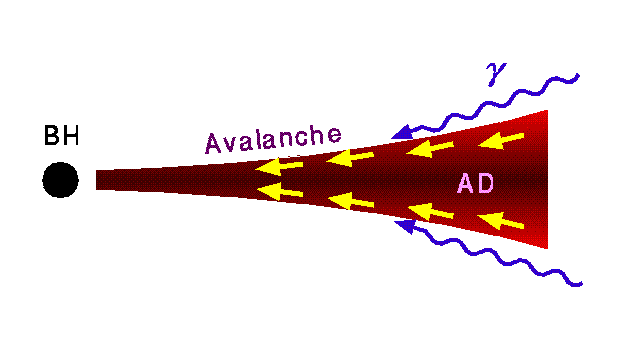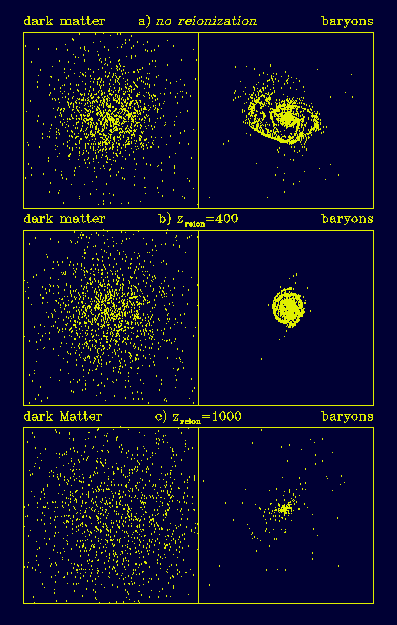English Version



ここ数年,HSTを含む観測の目覚ましい進展により,銀河内の活発な星形成過程と
クェーサー/AGN現象に何らかの強い関連があるという証拠が急増してきた。昨今の
HST観測では, 近傍のかなりのクェーサーが明るい母銀河の中心にあることが示され
た。また, セイファート銀河の中心領域には, 爆発的星形成領域が多く見つかって
きている。さらに最近, 遠方のクェーサーに見つかった大量の分子ガスとダストは,
母銀河である原始銀河がかなり短い時間で爆発的星形成を行い,これが何らかの形で
クェーサー活動性と結び付いていることを示唆している。
我々は, クェーサー/AGNと爆発的星形成の強い繋がりを説明する物理的メカニズム
として、星形成領域からの強力な輻射場による輻射摩擦によって, 中心核を取り囲
む回転ガス円盤から角運動量が効率よく抜き取られ, さながら「なだれ」的に中心
に落ち込むという「輻射性なだれ」モデルを提唱した。この「輻射性なだれ」は,
数pc-100pcの領域では, 通常のα粘性による降着よりも速い。また,銀河中心のバー
不安定による質量降着は, 数10pc程度までが限界であることがわかってきており,
「輻射性なだれ」は, バー不安定が効く数10pcまでと, α粘性が効く1pc以下の間を
繋ぐ第3の質量降着メカニズムと見ることができる。

輻射性なだれのイメージ図
References
- "Radiative Avalanche による AGN Fuelling"
梅村雅之,福江純,嶺重慎,
理研研究会「X線でAGNに迫る」, 74-78 (1997)
[ Proceedings (HTML) ]
- "Radiative Avalanche: Starburst Induced Fuelling to AGNs"
M. Umemura, J. Fukue, and S. Mineshige,
Astrophysical Journal Letters, 1997, 479, L97-L100
- "Radiative Avalanche Driven by Spherical Starbursts"
J. Fukue, M. Umemura, and S. Mineshige,
Publ. Astron. Soc. Japan, 1997, 49, 673-677

大質量ブラックホール形成を調べるために、宇宙晴れ上がり直後の密度ゆらぎの
非線形成長を3次元流体計算コードを用いてシミュレートした。この計算では、宇
宙論的降着円盤の形成と分裂、そしてコンプトン粘性による角運動量輸送を計算し
なければならないため、3次元流体粒子法を用いた。この力学系では,熱制動放射、
共鳴線遷移、コンプトン散乱、輻射性再結合などのバリオンガスの熱力学的効果だけ
でなく,ダークマターやガスの自己重力が重要な役割をする。また、電離過程の時間
発展も、進化に大きな影響を与えるため、これらの物理過程を採り入れた計算を行な
った。宇宙モデルはバリオンのみの場合とバリオンとダークマターが共存する場合の
両方を調べた。この計算によって明らかにされた大質量ブラックホール形成のシナリオ
は以下のようなものである。まず、宇宙初期の密度ゆらぎは、重力不安定性によって
高密度ガス雲に成長する。このとき、ゆらぎは角運動量を獲得するため、1点に凝縮
することはなく、回転降着円盤ができる。この降着円盤の内部では、局所的重力不安定
が起こるため、そこで第1世代の星が誕生する。ガス円盤の約10%が星に転換される
と、残りのガスは星からの紫外線によって完全電離状態となる。すると、この電離プラ
ズマと宇宙背景放射の間のコンプトン摩擦が急激に強くなり、プラズマから宇宙背景
放射へ角運動量の輸送が起こる。その結果、降着円盤は急速に凝縮していき、非常に
コンパクトな系が出来上がることになる。このコンパクトなガスコアは一般相対論的
に不安定となり、宇宙年齢の10万分の1程度の時間で大質量ブラックホールへと進化
することが示された。

巨大ブラックホール形成のシミュレーション
References
- "Early Cosmic Formation of Massive Black Holes"
M. Umemura, A. Loeb, and E. L. Turner,
Astrophysical Journal, 1993, 419, 459-468
- "Reionization of the Universe due to Early-Formed Massive Black Holes"
S. Sasaki and M. Umemura,
Astrophysical Journal, 1996, 462, 104-109
- "Very Strong Microlensing of Distant Luminous Stars by Relic
Massive Black Holes"
E. L. Turner and M. Umemura,
Astrophysical Journal, 1997, 483, 603-607

-
An X-Ray Microlensing Test of AU-Scale Accretion Disk Structure in Q2237+0305
A. Yonehara, S. Mineshige, T. Manmoto,
J. Fukue, M. Umemura, and E. L. Turner
Astrophysical Journal Letters, 501, 41-44 (1998)
[astro-ph/9804251]
-
Microlens Diagnostics of Accretion Disks in Active Galactic Nuclei
A. Yonehara, S. Mineshige, J. Fukue, M. Umemura, and E. L. Turner
Astronomy & Astrophysics, submitted (1998)
[astro-ph/9710190]
The innermost regions of quasars can be resolved by a gravitational-lens
telescope on scales down to a few AU.
This is because the radiation, especially X-rays from the innermost
region can selectively be amplified during microlensing events.
If detected, such X-ray variation will constrain
the size of X-ray emitting region down to a few AU.
Importantly, the maximum attainable resolution depends mainly on
the observational sampling interval of the lens event,
which can be much shorter than the crossing time.
On the basis of this idea,
we performed numerical simulations of microlensing of
an optically-thick standard-type disk and
an optically-thin, advection-dominated accretion flow (ADAF)
by the so-called `caustics crossing' events.
Calculated spectral variations and light curves show distinct
behavior, depending on the photon energy.
Optical-UV fluxes, which are likely to come from an optically thick part,
exhibit gradual light changes over a few tens of days,
since radiative cooling is balanced with viscous heating
in the disk so that emissivity variation roughly reflects
the shape of the potential well.
Its variability timescale is consistent with that of the
microlensing events observed in Q2237+0305.
As for X-ray radiation which is produced in an optically thin part,
in contrast, somewhat shorter intensity variation
is expected at maximum light.
Currently, Q2237+0305 is being monitored in the optical range
at Apache Point Observatory.
Simultaneous multi-wavelength observations by HST and X-ray sattelites
(e.g., ASCA, AXAF, XMM) are urgently required at the time of
the microlens event to reveal
a small scale structure of the central accretion disk around black hole.

-
Self-Similar, Self-Gravitating Viscous Disk
S. Mineshige and M. Umemura
Astrophysical Journal Letters, 469, L49-L51 (1996)
-
Self-Similar Collapse of Self-Gravitating Viscous Disk
S. Mineshige and M. Umemura
Astrophysical Journal, 480, 167-172 (1997)
[astro-ph/9701189]
-
Self-Similar Viscous Collapse of a Self-Gravitating, Polytropic Gas Disk
S. Mineshige, K. Nakayama, and M. Umemura
Publ. Astron. Soc. Japan, 49, 439-443 (1997)
We find a self-similar solution for the self-gravitational viscous disk.
The disk structure is characterized by three parameters:
viscosity parameter, alpha, the ratio of a disk thickness to a radius,
and a mass-flow rate. The solution shows that
a non-viscous, isothermal rotating disk modeled by Mestel
can be extended to a viscous accretion disk.
The solution is discussed in the context of formation
of a quasar black hole.

-
Optical Variability of Active Galactic Nuclei: Starbursts or
Disk Instabilities ?
T. Kawaguchi, S. Mineshige, M. Umemura, and E. L. Turner
Astrophysical Journal, in press (1998)
[astro-ph/9712006]
Aperiodic optical variability is a common property of
Active Galactic Nuclei (AGNs), though its physical origin
is still open to question.
We compare light curves among the following two models and the observation
of quasar 0957+561 in terms of structure function analysis,
to make clear the origin of the optical -- ultraviolet
variability in AGNs.
In the starburst (SB) model random superposition of supernovae
in the nuclear starburst region
produce aperiodic luminosity variations,
while in the disk-instability (DI) model variability is caused by some
instabilities in the accretion disk atmospheres around a
supermassive black hole.
We calculated fluctuating light curves and structure functions
by simple Monte-Carlo simulations on the basis of the two models.
Each resultant structure function possesses a power-law portion.
The two models can be distinguished by the logarithmic slope, $\beta$.
$\beta \sim$ 0.74--0.90 in the SB model and
$\beta \sim$ 0.41--0.49 in the DI model,
while the observed light curves exhibit $\beta \sim$ 0.35.
Therefore, we conclude that the DI model is more favored over
the SB model to explain the slopes of the observational
structure function in the case of 0957+561.

![]()
![]()
![]()
![]()

![]()

![]()
![]()
![]()
![]()